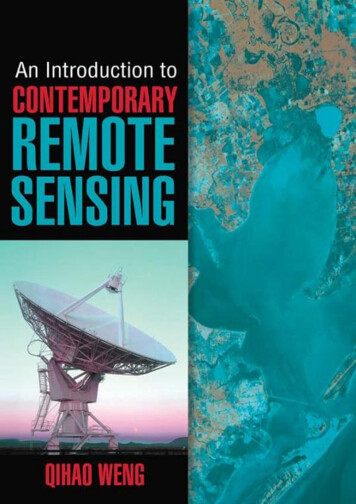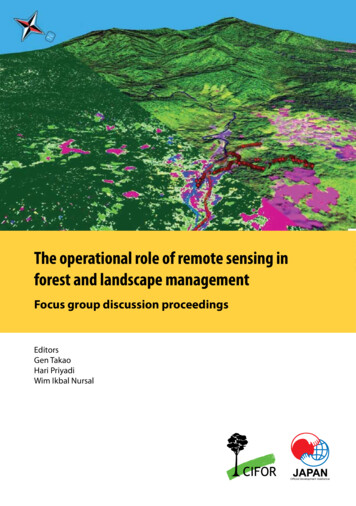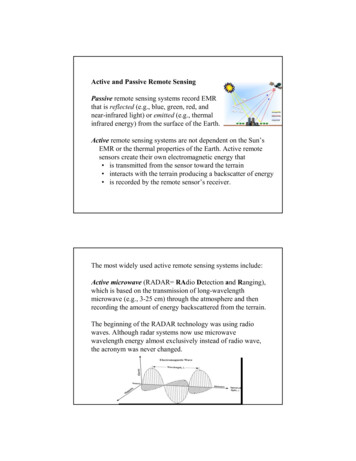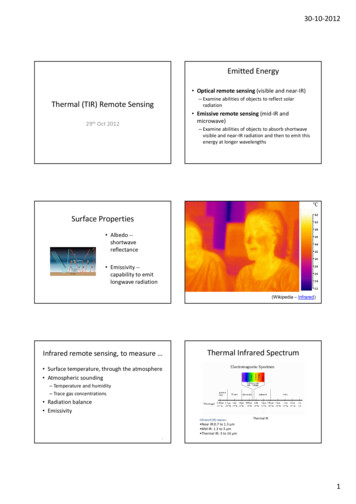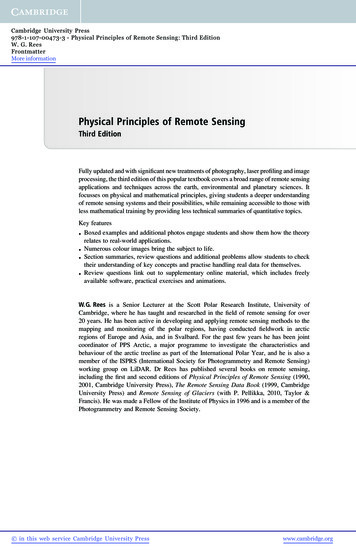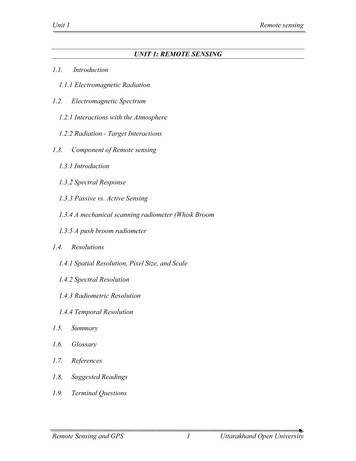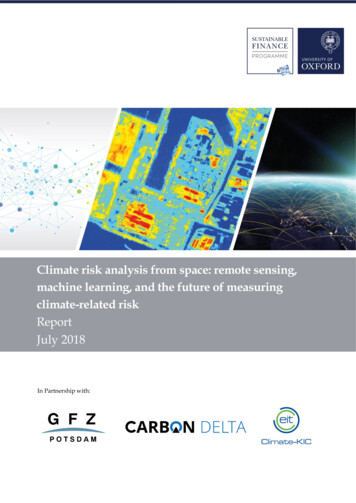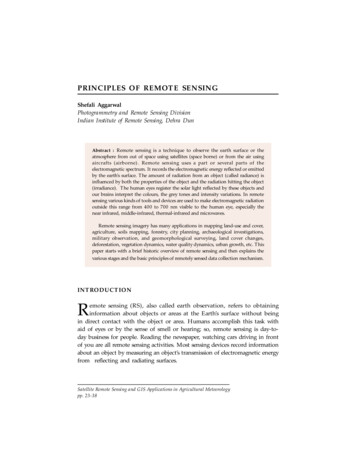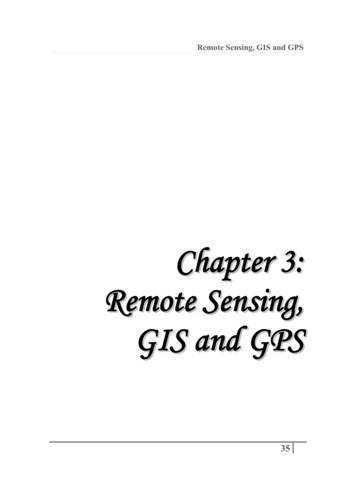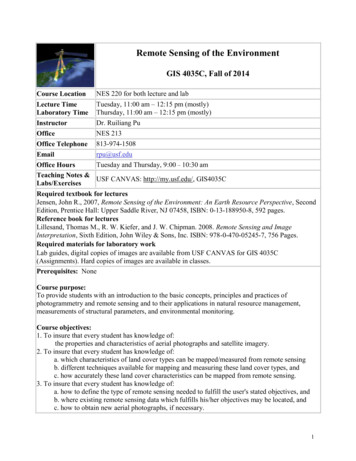
Transcription
Remote Sensing of the EnvironmentGIS 4035C, Fall of 2014Course LocationNES 220 for both lecture and labLecture TimeLaboratory TimeTuesday, 11:00 am – 12:15 pm (mostly)Thursday, 11:00 am – 12:15 pm (mostly)InstructorOfficeOffice TelephoneDr. Ruiliang PuNES 213813-974-1508rpu@usf.eduEmailTuesday and Thursday, 9:00 – 10:30 amOffice HoursTeaching Notes &USF CANVAS: http://my.usf.edu/, GIS4035CLabs/ExercisesRequired textbook for lecturesJensen, John R., 2007, Remote Sensing of the Environment: An Earth Resource Perspective, SecondEdition, Prentice Hall: Upper Saddle River, NJ 07458, ISBN: 0-13-188950-8, 592 pages.Reference book for lecturesLillesand, Thomas M., R. W. Kiefer, and J. W. Chipman. 2008. Remote Sensing and ImageInterpretation, Sixth Edition, John Wiley & Sons, Inc. ISBN: 978-0-470-05245-7, 756 Pages.Required materials for laboratory workLab guides, digital copies of images are available from USF CANVAS for GIS 4035C(Assignments). Hard copies of images are available in classes.Prerequisites: NoneCourse purpose:To provide students with an introduction to the basic concepts, principles and practices ofphotogrammetry and remote sensing and to their applications in natural resource management,measurements of structural parameters, and environmental monitoring.Course objectives:1. To insure that every student has knowledge of:the properties and characteristics of aerial photographs and satellite imagery.2. To insure that every student has knowledge of:a. which characteristics of land cover types can be mapped/measured from remote sensingb. different techniques available for mapping and measuring these land cover types, andc. how accurately these land cover characteristics can be mapped from remote sensing.3. To insure that every student has knowledge of:a. how to define the type of remote sensing needed to fulfill the user's stated objectives, andb. where existing remote sensing data which fulfills his/her objectives may be located, andc. how to obtain new aerial photographs, if necessary.1
4. To insure that every student has knowledge ofa. basic concepts on photographic & non-photographic remote sensing,b. general principles of interpreting different types of remote sensing images, andc. potential applications of remote sensing to natural resource management and related fields.5. To insure that every student knows or learnsa. how to open remote sensing images with ENVI image processing system,b. how to display or composite a multispectral image with the system, andc. how to interpret the displayed images with the system.Grading and evaluation:Exams will cover key concepts and principles from lectures, laboratory and exercise activities. Allwritten assignments must be typewritten, word-processed, or similarly computer-generated andhanded in electronic copy (via USF Blackboard system) on time.Laboratories/Exercises30%Mid-Term Examination30%Final Examination30%Class attendance10%Total100%NOTE ON WITHDRAWALS AND INCOMPLETES: Withdrawals from this course are students'responsibility, and the instructor will not withdraw or drop students from this class under anycircumstances. Incomplete grades will not be given except in the case of extraordinary circumstancesrelated to serious illness, bereavement, or personal crises. Documentation will be required in theselimited cases.Laboratory activities and assignments – We will work through some laboratory/exercise activitiesspecified in additional documents to aid in understanding technical concepts taught in lectures. Wewill also explore some of the technical facets of ENVI software in a latest version. In some of ourlab classes, we will be working through ENVI to help prepare students for manipulating images andunderstanding lecture contents.Students with disabilities: Instructor subscribes to university policy on students with disabilitieswho may have special needs in meeting class requirements. Students with physical, psychological, orlearning disabilities and in a need of academic accommodations for a disability may consult withStudents with Disabilities Services (SDS) to arrange appropriate accommodations. The students arerequired to give reasonable notice prior to requesting an accommodation. If you have a documenteddisability and anticipate needing accommodations in this course, please meet with instructor soon.Policy on attendance and due-dates for assignments: Timely attendance in class is required andforms a portion of your grade. Failure to meet course requirements due to illness will requiredocumentation for alternate arrangements to be made. If you have a scheduling conflict or personalsituation that will cause you to arrive late to class or leave early on a regular basis, please show thecourtesy to advise the instructor ahead of time. Exercises or other written reports will be accepted2
after the due date, but some degree of penalty for late work will be applied.Make-up exam policy: The School of Geosciences does not allow make-up exams except forstudents in special circumstances and at the discretion of the faculty member teaching the course.These special circumstances include: (1) death or illness in the student's family or of a friend; (2)student illness; (3) three or more examinations on the same day; (4) participation in a universitysponsored activity at the time of a regularly scheduled examination. Make-up examinations will notbe granted for personal convenience or for travel. Make-up examinations will be granted only if thecircumstances above are documented. Advanced arrangements must be made for the situationsdescribed in (3) and (4). Otherwise, if you miss an exam, you receive a score of 0 for itSeeking help and access to faculty: If you feel that you are having difficulty keeping up with classassignments or in understanding the material we are covering, please see instructor as soon aspossible! Please note the office hours posted at the beginning of the syllabus. If you cannot make itduring these hours, please contact instructor via EMAIL or phone to make an appointment.classroom rules: 1) Please respect each other. 2) Cell phones, pagers, and other noise-makingdevices must be turned off during class. If your cell phone or pager goes off during class, I may askyou to leave. If it goes off during an exam, you will be asked to leave and will receive a 0 for thatexam. 3) Please clean up after yourselves by disposing of any trash you generate. 4) Please do notread outside material (newspapers, etc.) during class. 5) If you are more than 15 minutes late forclass, please wait for a break to enter the classroom.In the event of an emergency: It may be necessary for USF to suspend normal operations. Duringthis time, USF may opt to continue delivery of instruction through methods that include but are notlimited to: CANVAS, Elluminate, Skype, and email messaging and/or an alternate schedule. It’s theresponsibility of the student to monitor CANVAS site for each class for course specificcommunication, and the main USF, college, and department websites, emails, and MoBull messagesfor important general information.This syllabus is subject to change. Always consult with the course instructor if you have questionsabout course procedures or materials.CLASS SCHEDULEWeek #Date:1Aug 26Course Introduction and syllabusAug 28Lecture #1: Chapter 1: Remote Sensing of the EnvironmentChapter 3: History of Aerial Photography and Aerial Platforms2Subject:Sep 2Lecture #2: Chapter 2: Electromagnetic Radiation Principles (I)Sep 4Lecture #2: Chapter 2: Electromagnetic Radiation Principles (II)3
345678910111213Sep 9Lecture #3: Chapter 4: Aerial Photography – Vantage point, Camera,Filters, and FilmSep 11Lab #1: Measurement & analysis of target reflectanceSep 16Lecture#4: FilmLecture #4: Chapter 5: Elements of Visual Image InterpretationSep 18Lab #2: Camera systems, films & band combinationSep 23Lecture #5: Chapter 6: Photogrammetry (I)Sep 25Lab #3: Image interpretation and analysisOct 30Lecture #5: Chapter 6: Photogrammetry (II), Midterm reviewOct 2Lab #4: Measuring objectives on vertical photographsOct 7Lab #5: Stereoscope viewing & measuringOct 9Mid-Term ExaminationOct 14Lecture #6: Chapter 7: Multispectral Remote Sensing Systems (I)Oct 16Lecture #6: Chapter 7: Multispectral Remote Sensing Systems (II)Oct 21Lab #6: Imagery on the internetOct 23Lecture #7: Chapter 7: Hyperspectral Remote SensingOct 28Lab #7: Multi/hyperspectral image analysisOct 30Lecture #8: Chapter 8: Thermal Infrared Remote SensingNov 4Lab #8: Thermal infrared image interpretationNov 6Lecture #9: Chapters 9-10: Active Remote SensingNov 11Lab #9: Analysis and interpretation of RADAR imagery No Class becauseof Veterans Day. SO all classes/labs moved forward one classNov 13Lecture #10: Chapters11-14: Remote Sensing Applications (I)Nov 18Lecture #10: Chapters11-14: Remote Sensing Applications (II)Nov 20Lecture #10: Chapters11-14: Remote Sensing Applications (III)4
141516Nov 25Lab #10: Remote sensing applicationsNov 27No classes, Thanksgiving DayDec 2Final review (lectures and lab/exercises)Dec 4Review for final examinationDec 9Tuesday, Final examination: 10:00 am -12:00 pm, NES220.5
Remote Sensing of the Environment GIS 4035C, Fall of 2014 Course Location NES 220 for both lecture and lab Lecture Time Laboratory Time Tuesday, 11:00 am - 12:15 pm (mostly) Thursday, 11:00 am - 12:15 pm (mostly) Instructor Dr. Ruiliang Pu Office NES 213 Office Telephone 813-974-1508 Email rpu@usf.edu


